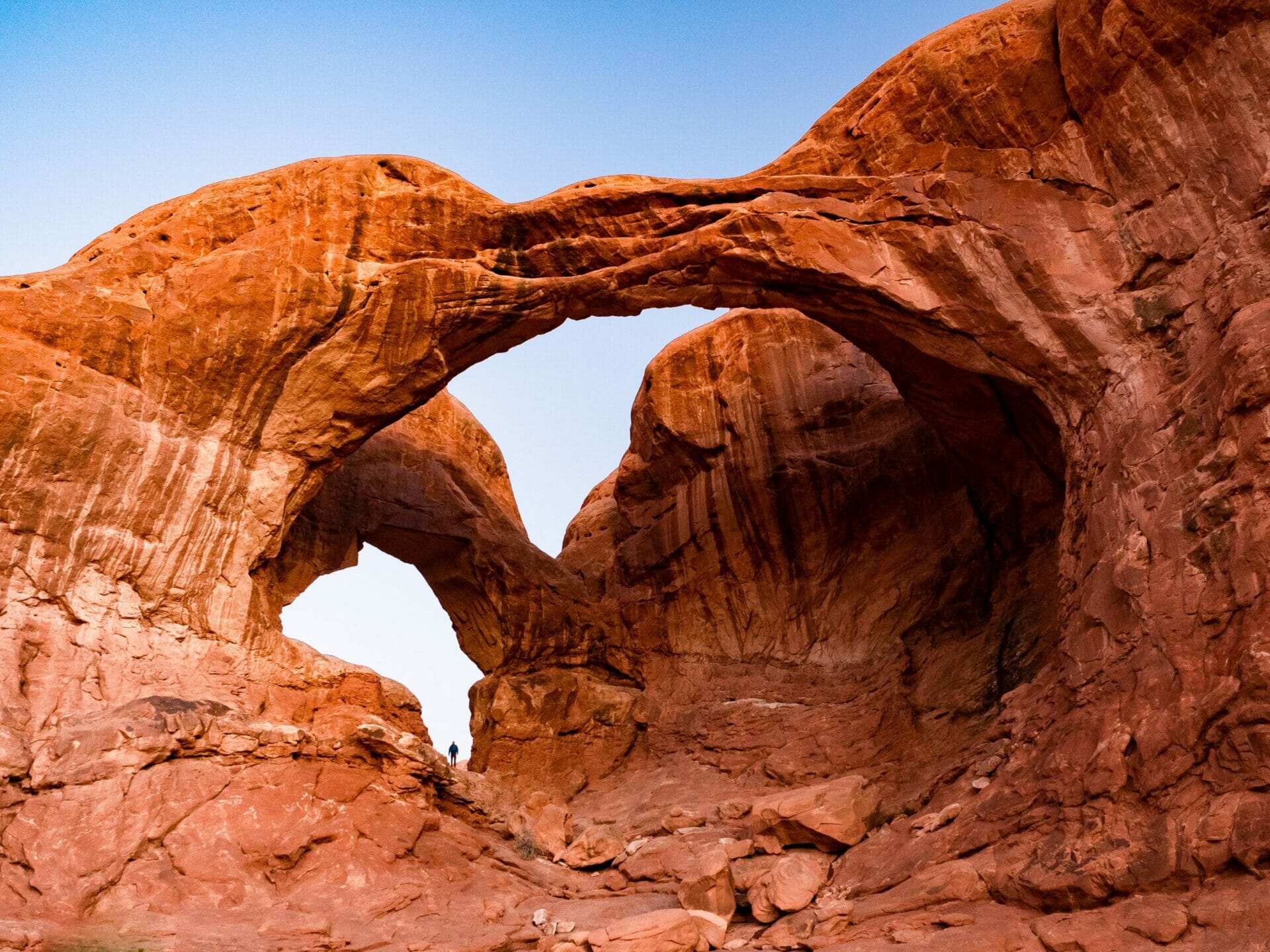
The ultimate 1-day Arches National Park itinerary: 17 best viewpoints & hikes (post-COVID)
Last Updated on 20 August 2025
Boasting over 2,000 natural rock arches, each the product of millions of years of violent wind, salt, and ice erosion in south-eastern Utah, Arches National Park certainly earns its name. And no two arches are alike— spectacularly thin bridges of rock stretch over desert landscapes, isolated ribbons twist on cliff edges, and windows through the red sandstone reveal snow-capped peaks in the distance. It honestly feels like each arch is more spectacular than the last.
Although there are countless hidden gems to explore within Arches, as well as more remote hikes that require additional time, you can still experience all of the park’s major highlights within a single day. This 1-day itinerary for Arches National Park showcases no fewer than 15 arches, beginning with sunrise at Double Arch and the Windows, featuring a fascinating hike through Devil’s Garden, and finally concluding with sunset at popular Delicate Arch.
Read on to discover absolutely everything you need to know for the ultimate day at Arches National Park, including when to visit, how to get there and where to stay nearby, COVID closures and park health measures, essential packing list, and a super detailed 1-day itinerary with all the best viewpoints and hikes.
Check out other posts in my 1-day National Park & Public Land series:
- Alabama Hills National Scenic Area
- Bryce Canyon National Park COMING SOON
- Canyonlands National Park
- Death Valley National Park
- Grand Canyon National Park COMING SOON
- Joshua Tree National Park
- Red Rock Canyon National Conservation Area
- Saguaro National Park COMING SOON
- Valley of Fire State Park COMING SOON
- Yosemite National Park
- Zion National Park COMING SOON
Planning your trip
When to visit Arches National Park
Like most of Utah’s Mighty 5, Arches National Park is a year-round destination offering spectacular scenery and unique experiences 12 months of the year:
Summer (June to September) remains the most popular time to visit the park, but with soaring temperatures into the high 40s (110F+) and enormous crowds, this is the least advised time to explore Arches. If you do visit in summer, get up early to minimise time outside in peak afternoon heat and be prepared to queue up for photos at popular viewpoints.
Autumn (September to November) & Spring (March to May) each boast fantastic daytime temperatures (20C/68F) and mostly clear skies with fewer visitors, but be warned that early mornings and nights can still be incredibly cold (5C/40F), so pack plenty of layers. This is absolutely the best time to visit Arches, since you’ll be able to see everything you want without fighting crowds of people and still enjoy mostly sunny days.
Winter (November to February) can also be a good time to visit Arches, with cooler days and the lowest number of visitors, but expect the nights to be well below freezing and for very short daylight hours to somewhat limit your itinerary. There’s a distinct possibility of snow in the winter, but the roads are plowed and severe storms are pretty unlikely at this elevation (as opposed to Bryce Canyon). It’s definitely not advised to camp in winter, so plan on getting a hotel in Moab (see accommodation recommendations below), but the reward will be relative solitude!
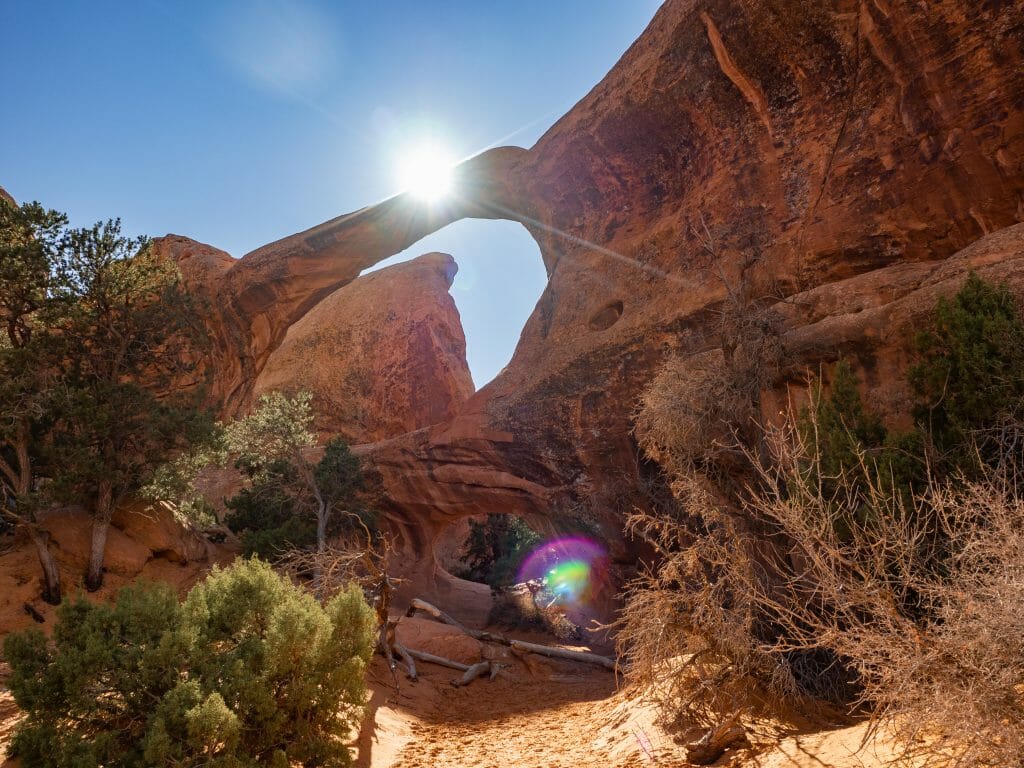
Buying a parks pass for Arches National Park
As with the entire NPS network, there are fees associated with visiting Arches National Park. If you are only exploring the park for a single week and not planning to visit any other national parks in the next year, you can purchase a 7-day access pass for $30USD at the entrance, which covers all people within your car.
If you plan on visiting more than 3 US national sites in the next 12 months, it’s actually cheaper to get an annual parks pass for $80USD, accepted at all 63 national parks and thousands of other national monuments and forests around the country.
Purchase your America the Beautiful Pass onsite (from the ranger station upon entry or the visitor centre located just inside the park entrance), at Recreation.gov, or even in-store or online from outdoor retailers like REI.
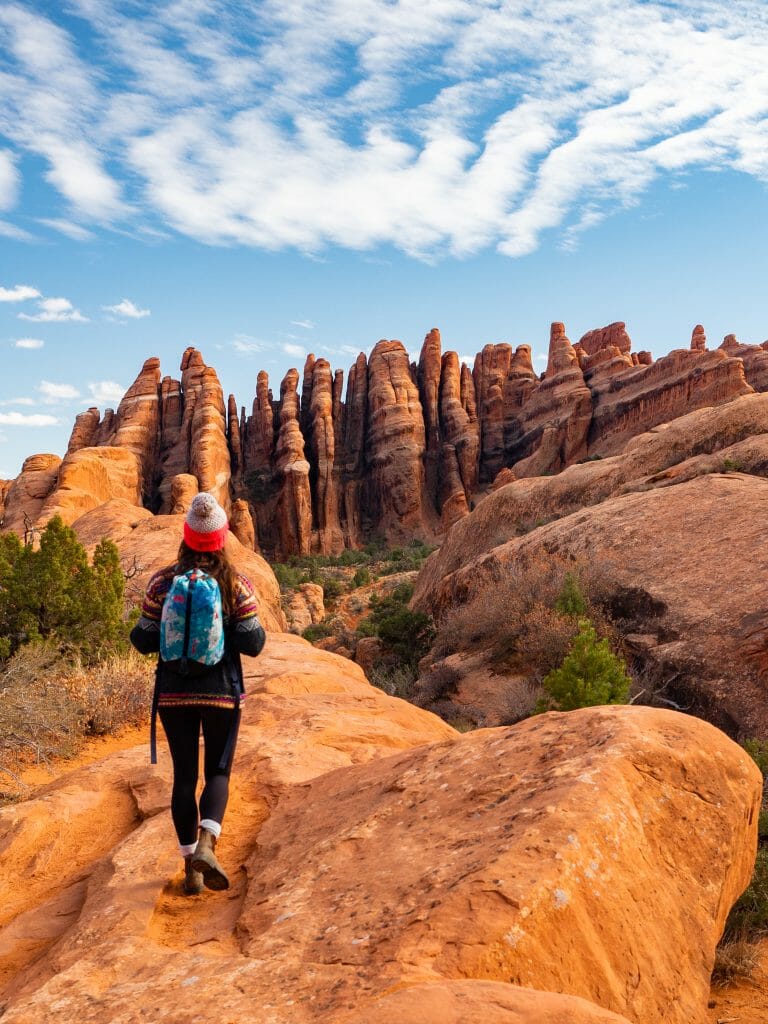
COVID-safe in Arches National Park
In response to the COVID-19 pandemic and in light of public health advice from the CDC, the National Parks Service has implemented a number of health and safety measures across the entire network of US parks, mostly to minimise proximity between travellers and prevent the contamination of shared surfaces.
As of early 2021, Arches National Park is open with a few restrictions:
- All travellers to the park are discouraged from interacting closely with people outside their party. Obviously this is difficult to enforce, but try to maintain a safe distance (2m) from other travellers at viewpoints, campsites, and on the trail.
- You are not required to wear a mask while hiking, but are encouraged to do so when it’s not possible to physically distance from people outside your party. I’d estimate about 50% of people at viewpoints were wearing masks during my November 2020 visit.
- The visitor centre (located just inside the park entrance) is currently CLOSED, but you can still get a map from the ranger station when you drive through.
- Fiery Furnace, a spectacular hike in the park that ordinarily requires either a permit or a ranger guide, is CLOSED for the foreseeable future.
- All other hikes and viewpoints within the park are open as normal, including Delicate Arch, Devil’s Garden, and The Windows. Popular trails can still be busy, so use common sense and respect your fellow travellers.
- Public restrooms are open throughout the park and hand sanitiser is provided.
- If you are feeling unwell, DO NOT VISIT! Follow local public health guidelines and get tested before visiting the national park.
For the latest updates on trail closures and COVID safety practices within Arches National Park, visit the NPS website.
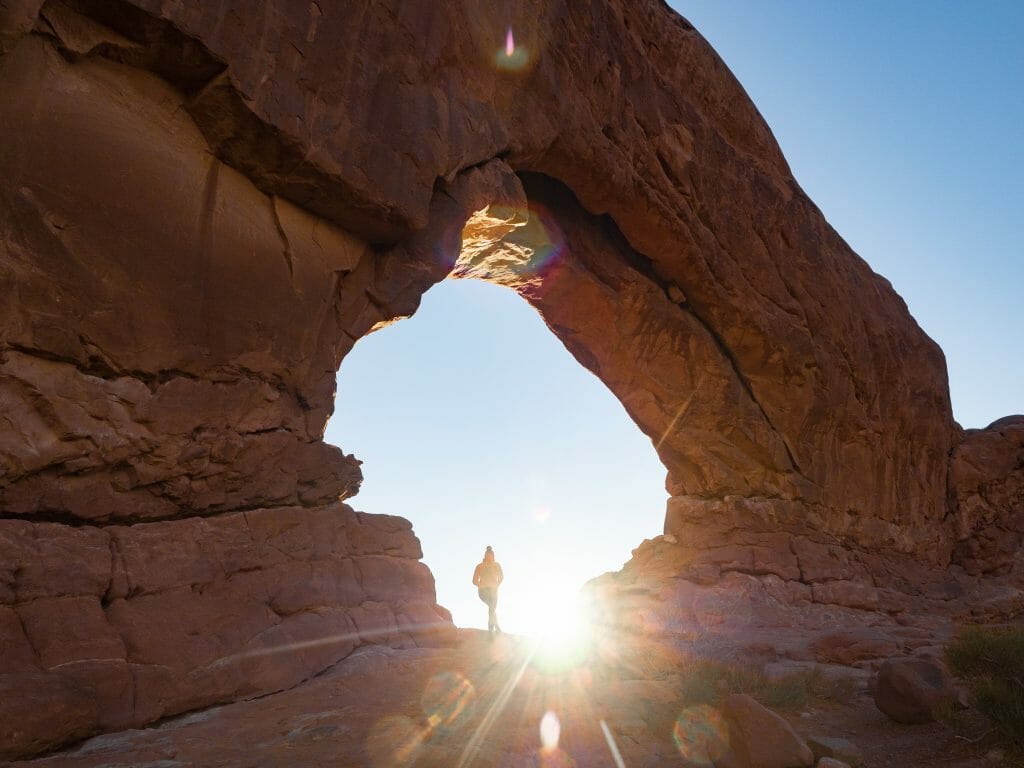
Getting to Arches National Park
Arches National Park is located just 5km/3mi from Moab, Utah, which has a small airport (Canyonlands Field Airport) and is also within spitting distance of Walker Field Airport (in Grand Junction, Colorado; 2hr drive). If time allows, though, Salt Lake City International Airport is likely to offer the cheapest and most direct flight, located 4hrs north of Arches. Conveniently, Moab is also the jumping off point for nearby Canyonlands National Park, so it’s easy to tuck in both of these parks in a single trip!

There is only one park entrance on the south end of Arches National Park, accessible on Highway 191 north from Moab or the 279 Scenic Byway. The visitor centre is also located at this main entrance, but note that it is still closed as of early 2021 due to COVID.
Getting around Arches National Park
Really, the only way to explore Arches National Park is in your own car; unlike some of the other Mighty 5, there is no park shuttle service operating in Arches. Thankfully, the park is incredibly accessible to essentially any car or driver and all roads are paved, so there’s no need to hire a 4WD.
Make sure to pick up a free map when you come through the entrance, as there is limited mobile reception within the park! Most viewpoints and hikes are extremely well signed, but it helps to have a paper map to plan your visit. If you miss grabbing a map (outside of staffed hours; typically 8am-5pm) or prefer to use your phone, there’s a downloadable version of the NPS map available here and I’ve also marked all my recommended stops on a handy Google Map (which you can save to your phone) in the itinerary section below.
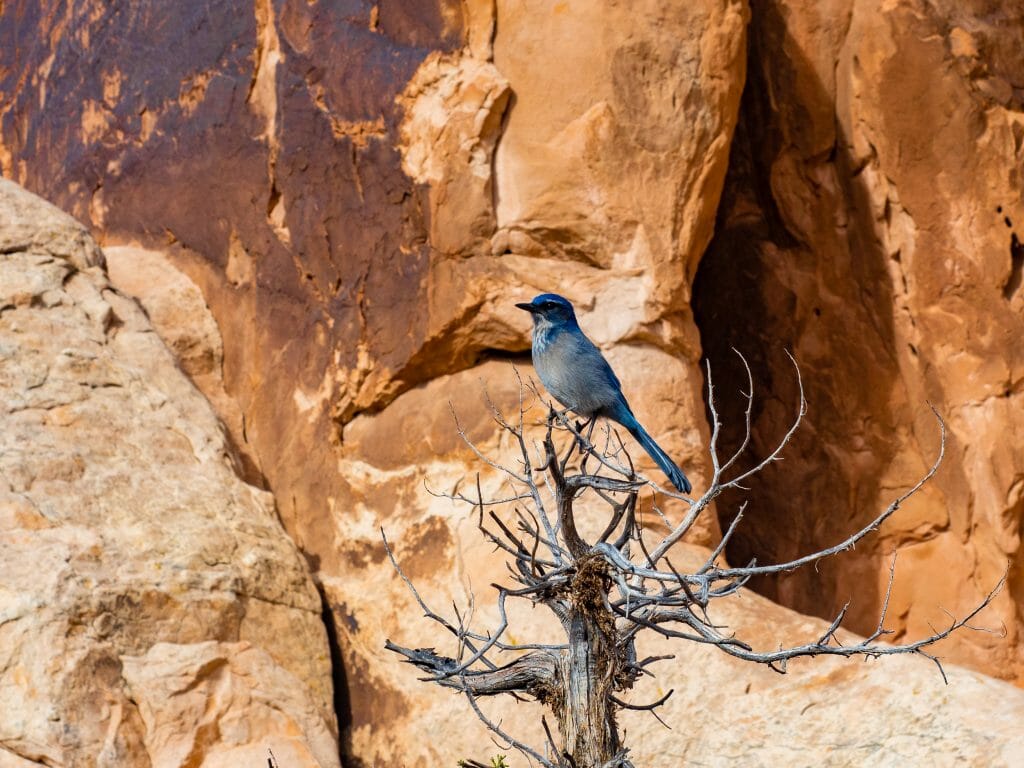
Where to stay near Arches National Park
If you’re hoping to stay near the park either before or after your visit, Moab, Utah is your best bet. This small town has heaps of lodging and food options and is just 5min from the entrance to Arches National Park. There is also one campground located within the park, but it fills up quickly, so be sure to book in advance!
- Bowen Motel | If opting to stay in Moab, this super basic but very affordable motel is a great choice; double rooms starting at $80.
- Big Horn Lodge | Another inexpensive and conveniently located motel just a few minutes’ drive from the park entrance; double rooms starting at $100.
- Devil’s Garden Campsite | The only campground within the national park is located right near the Devil’s Garden trailhead and requires reservations March to October; $25 per site.
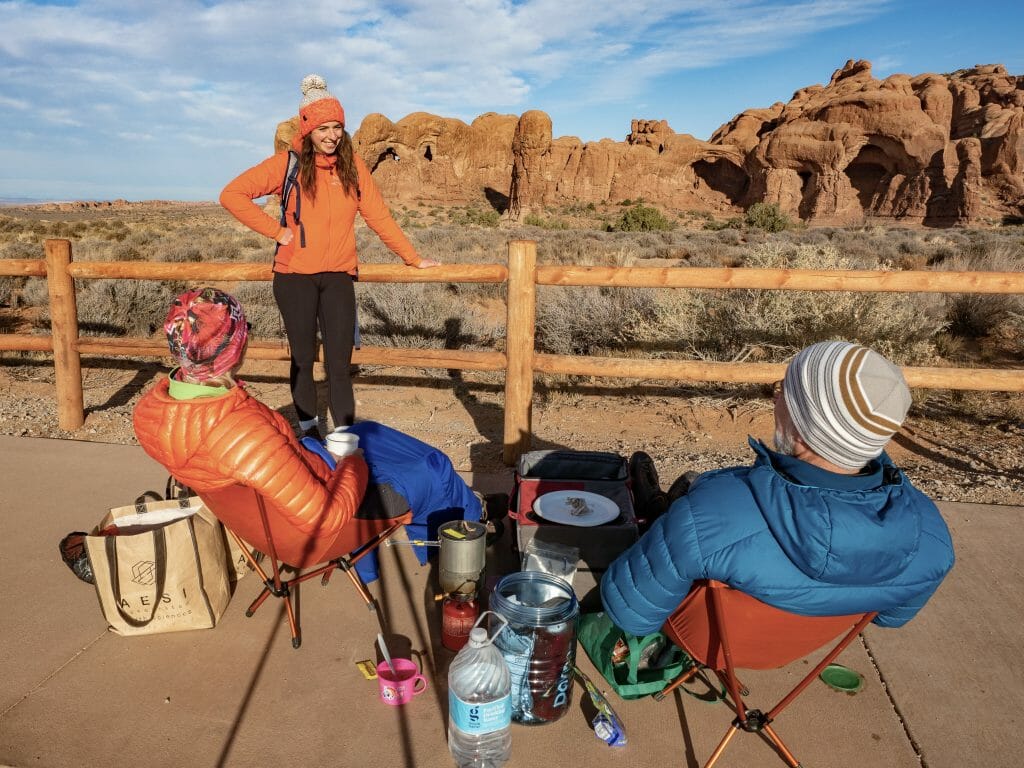
Packing list for Arches National Park
Although this is not intended to be a fully comprehensive packing list, here are some absolute essentials to pack for your day exploring Arches National Park:
- Day pack | I love my REI Flash 18 summit pack for short hikes in the national park
- Water bottle | Plan to carry a couple of litres in the car and on longer hikes, as there is no water available in the park and it can get HOT; this is an awesome bottle with a built-in filter
- Snacks | To maximise time exploring, you need to pack food for snacks and lunch, as there is nothing available inside the park; if you plan to picnic, it can also be great to bring compact camping chairs like these awesome REI Flexlite Camp Chairs and a small table
- Camera (+ tripod if you’re trying to capture sunrise and sunset shots)
- Hat | I wore my Akubra Traveller through all of Utah’s national parks and loved the sun coverage (not to mention all the compliments!); this is an Australian-made hat, but you can find it online at select retailers in the US and it is SO worth the money
- Boots or sturdy walking shoes | You can explore most of Arches in sturdy walking or hiking shoes, but I personally prefer boots when walking on sand/rock slabs and did all of the hikes on this itinerary in my square-toe 1306 Blundstones (also from Australia, but available in limited styles online in the US)
- Layers! | In autumn, spring, or winter, it is absolutely essential to have lots of layers, as temperatures can vary widely from early morning to mid afternoon; during my November visit, I would start out the morning in a down jacket, mountain jacket, fleece jumper and often be down to a t-shirt by midday
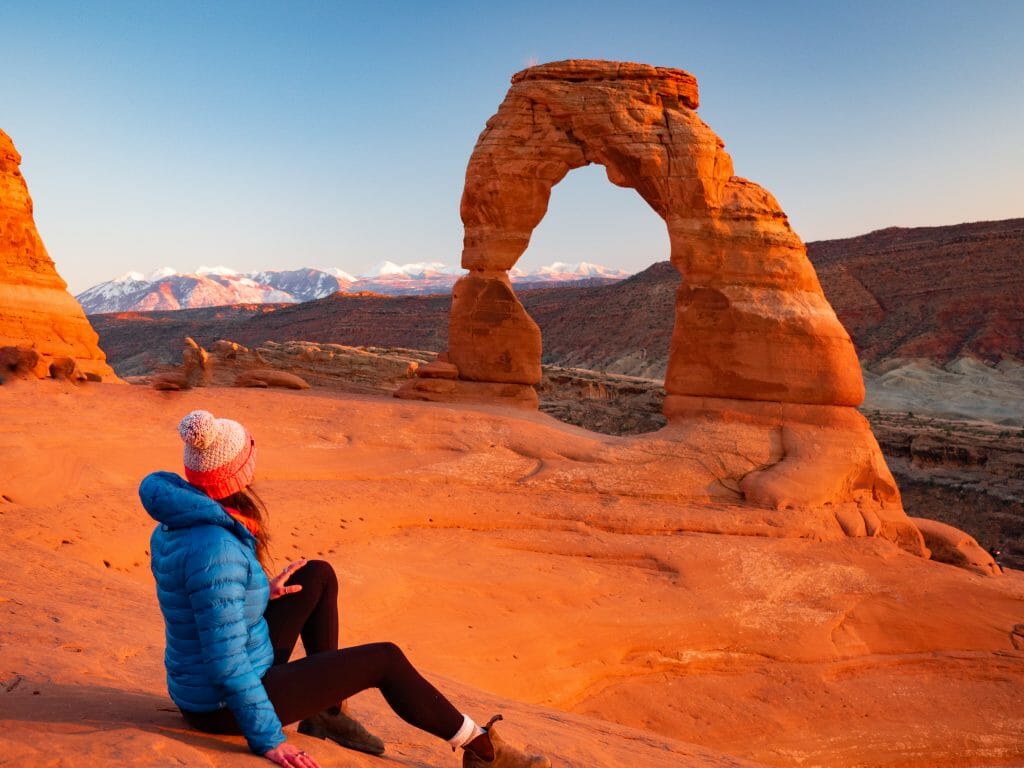
*1-day Arches National Park itinerary
The following itinerary packs the highlights of Arches National Park into a single day and is suitable for all times of year, including short winter days where you have limited daylight hours (7am to 5pm during my November visit). With longer summer days, you can probably add in a few extra stops or just move at a more relaxed pace!
You’ll first follow the main road that cuts north through the park (Arches Scenic Drive) and then turn off a short distance to explore The Windows Section, which features a number of impressive arches and showcases some of the area’s most unique geology right from the car window. From here, drive to the end of Arches Scenic Drive to hike through the Devils Garden area before returning along the same road and detouring off towards Delicate Arch for sunset.
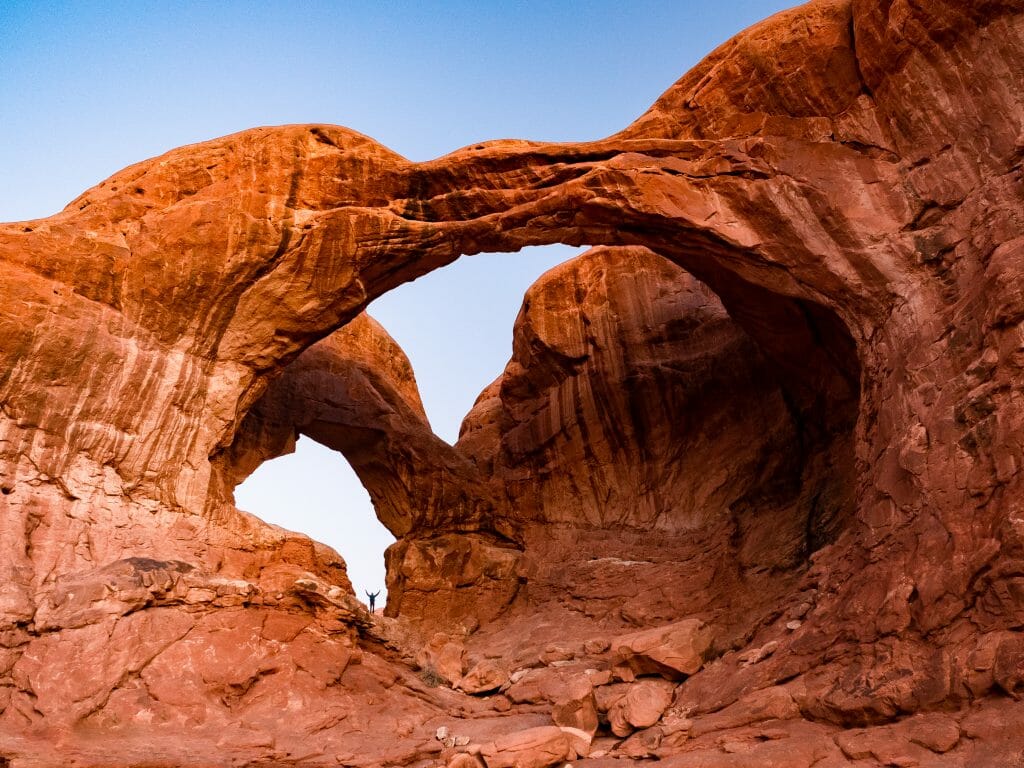
1 | Double Arch
800m / 0.5mi return | 10min
Wake up dark and early to catch sunrise at beautiful Double Arch, a soaring pair of red arches that bear uncanny resemblance to the chambers of a heart. It’s just a 5min walk from the carpark out to the arches, with plenty of fascinating geological features along the way, including one that I swear looks like marching elephants (see if you can spot it!).
Double Arch shares a carpark with The Windows, which is a very popular sunrise location— you could easily reverse the order of these first 2 stops, but I personally like Double Arch better for sunrise.
First light totally ignites the frontside of Double Arch in an insane shade of red, which you really only get on the backside of The Windows in the morning, and there’s also a small fraction of the people here (literally 2 when I visited vs several dozen clambering all over The Windows in the way of my camera). My advice is to hang around Double Arch until you get some good colour on the rocks and then head back to the carpark to see The Windows and Turret Arch (described below).
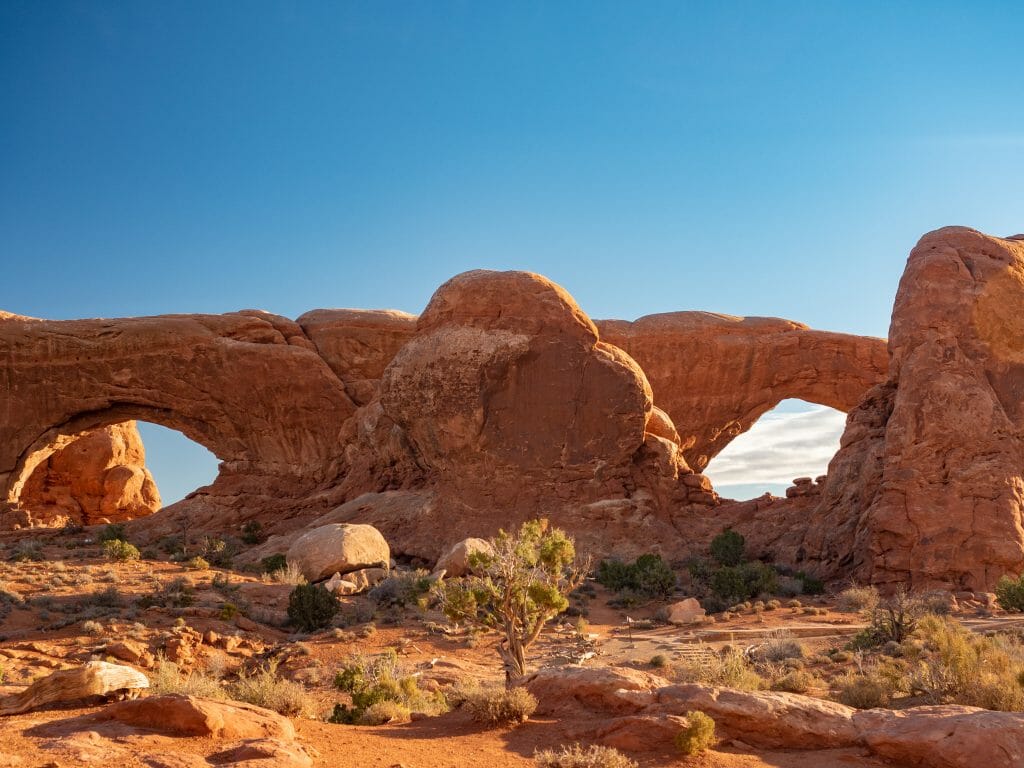
2 | The Windows (North & South Window)
1.6km / 1mi loop | 20min
From the same carpark as Double Arch, head the opposite direction along a short trail (less than 5min) towards The Windows, another pair of arches that look like spectacles when viewed from the right angle.
Aim to get here just after sunrise so you can catch the sunflare through North Window, and then continue along the flat path to the right to see the South Window.
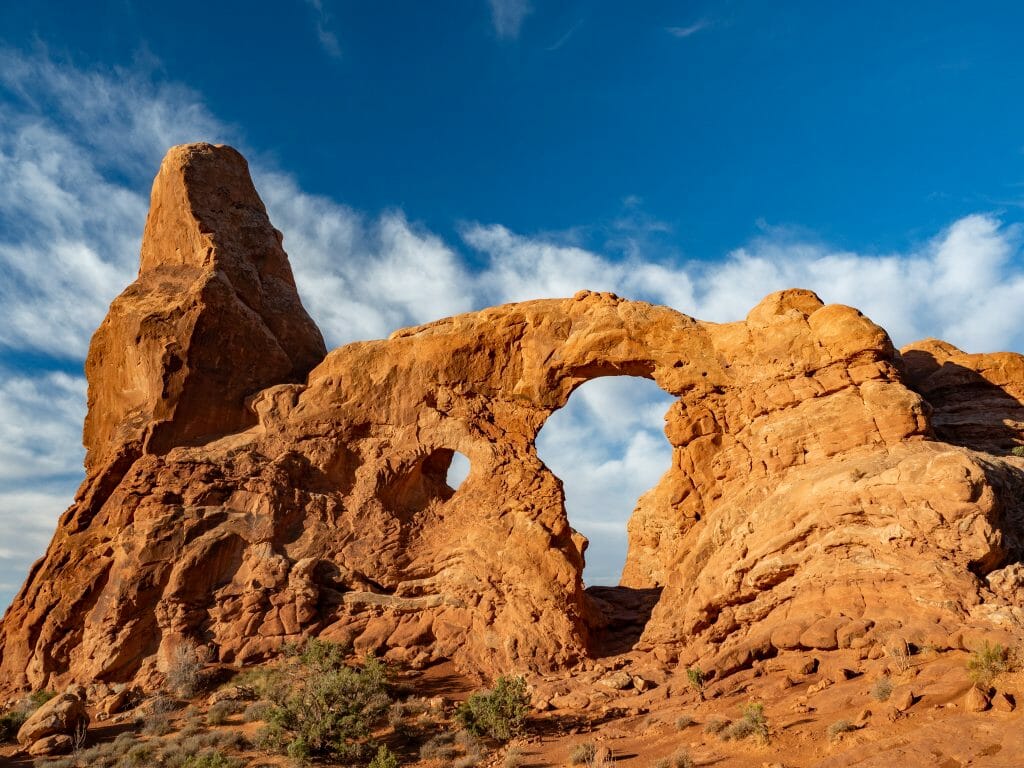
3 | Turret Arch
Along the same Windows Loop described above, you can also admire Turret Arch, which is pretty spectacular in the early morning light.
This is the smallest of the three arches along the trail (and is certainly dwarfed by Double Arch on the opposite side of the carpark), but it offers plenty of visual appeal, plus a fantastic view back onto The Windows.
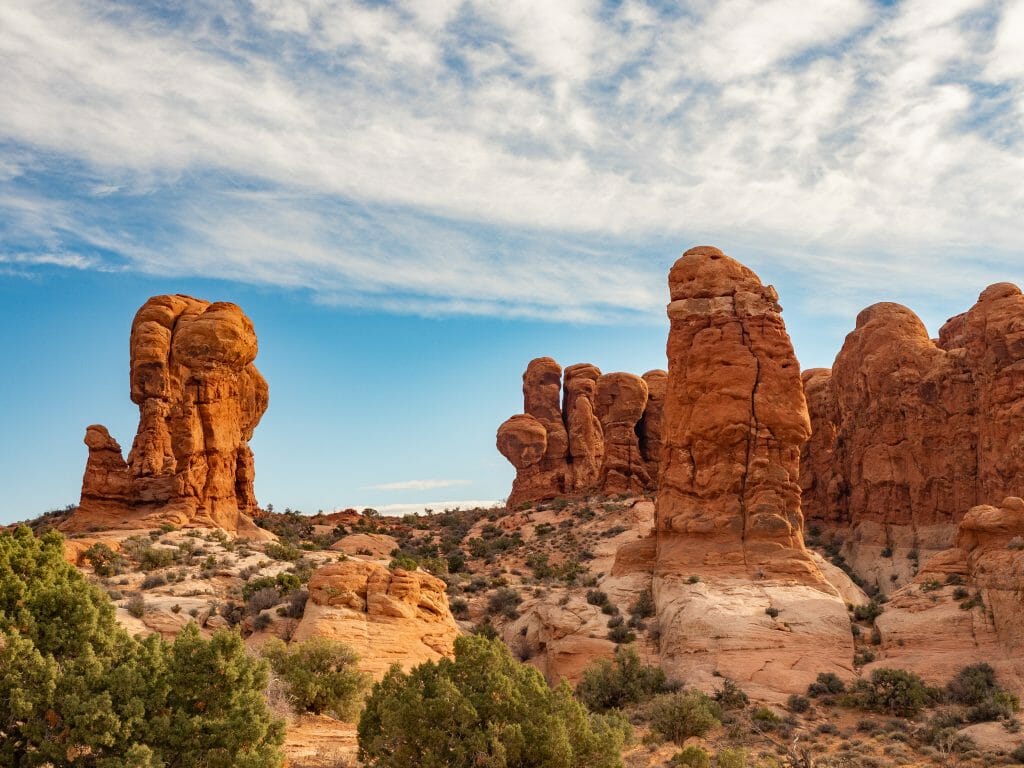
4 | The Garden of Eden
As you’re driving away from The Windows and Double Arch, you’ll pass a small signed lookout over The Garden of Eden, a spectacular assortment of wild and wonderful rock formations easily ogled from the road.
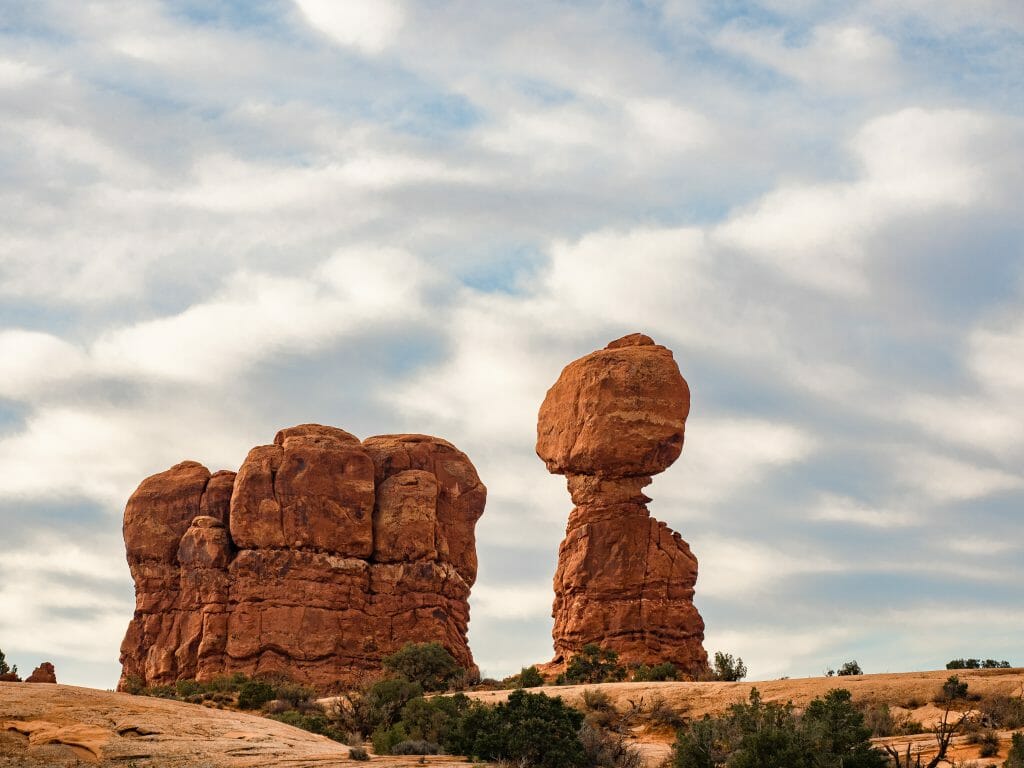
5 | Balanced Rock
Less than 5min down the road from The Garden of Eden is Balanced Rock (you’ll need to turn left to get to a pull-out where you can safely take a photo).
This is a super quick roadside stop, and no where near as spectacular as the arches on this list, but still worthwhile en route to the Fiery Furnace viewpoint.
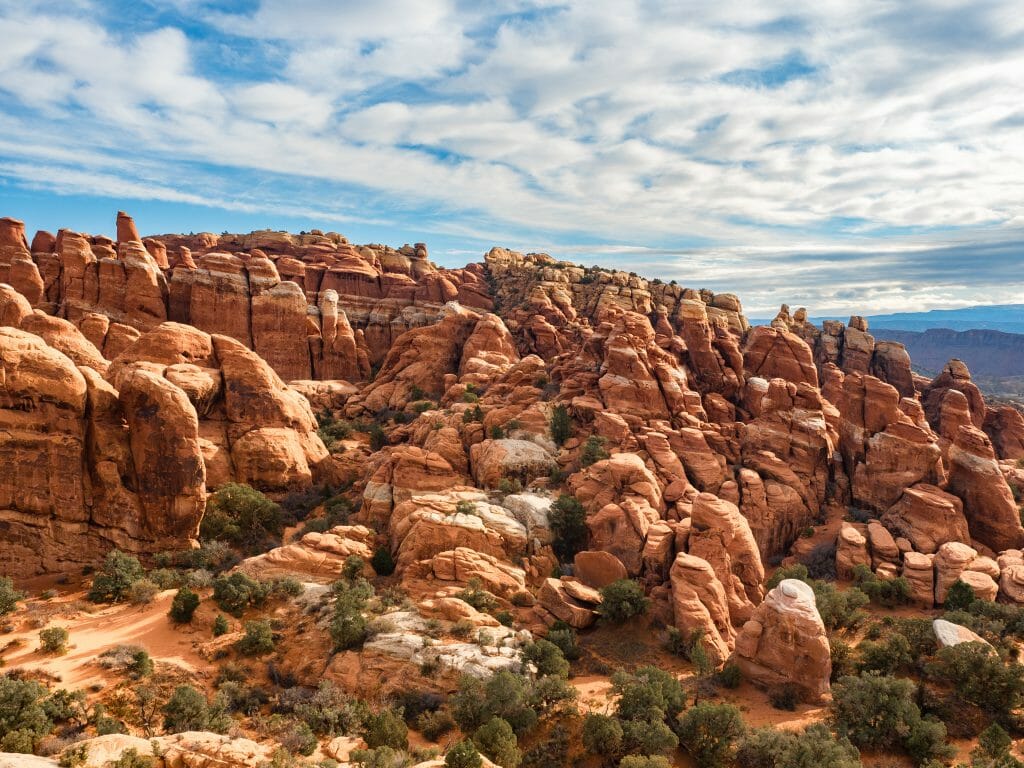
6 | Fiery Furnace viewpoint
You typically need a permit to hike through the narrow, silent canyons of the Fiery Furnace (which is presently closed due to COVID), but you can still admire its brilliant orange walls from a viewpoint along the main road.
Walk out a short distance for an even closer look at the striped sandstone and its labyrinthine erosion, a maze of narrow tunnels and tight rock walls leading through the wind-sheltered landscape.
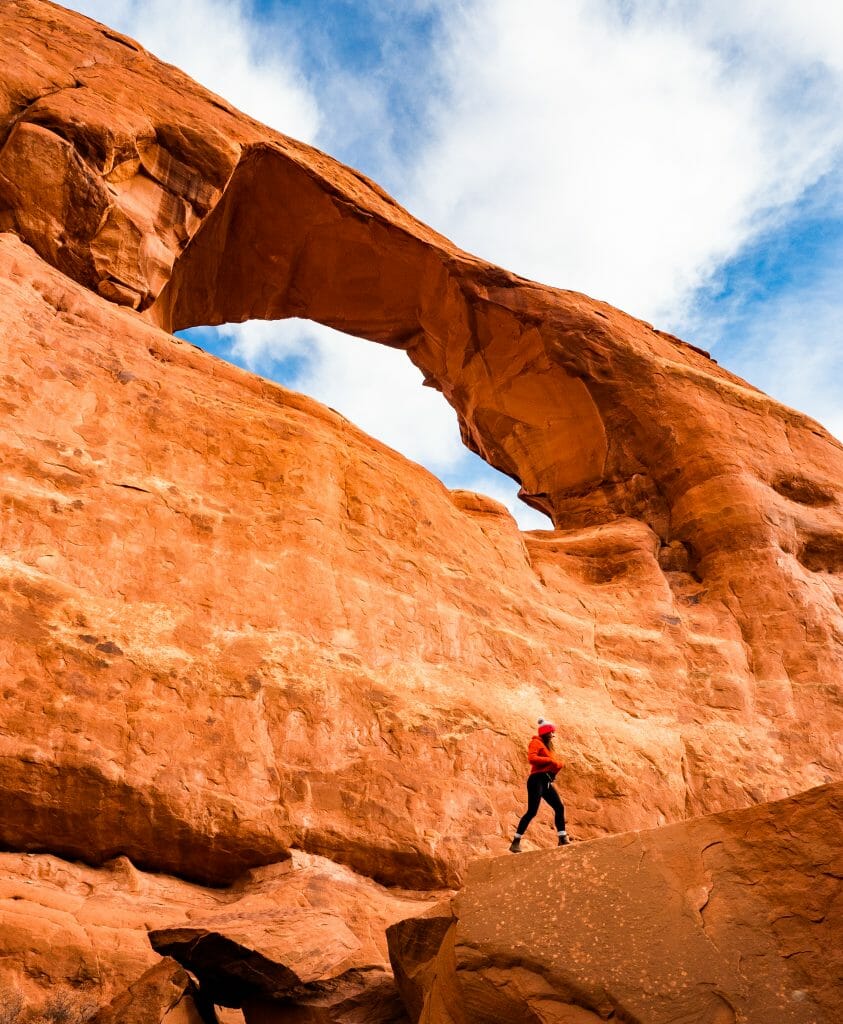
7 | Skyline Arch
600m / 0.4mi return | 10min
Although typically formed by slow erosion, Skyline Arch roughly doubled in size in 1940 when an enormous boulder tumbled out of its crescent opening.
Now, this soaring arch offers a picturesque glimpse of blue sky through orange rock, making it one of the more photogenic arches on the list.
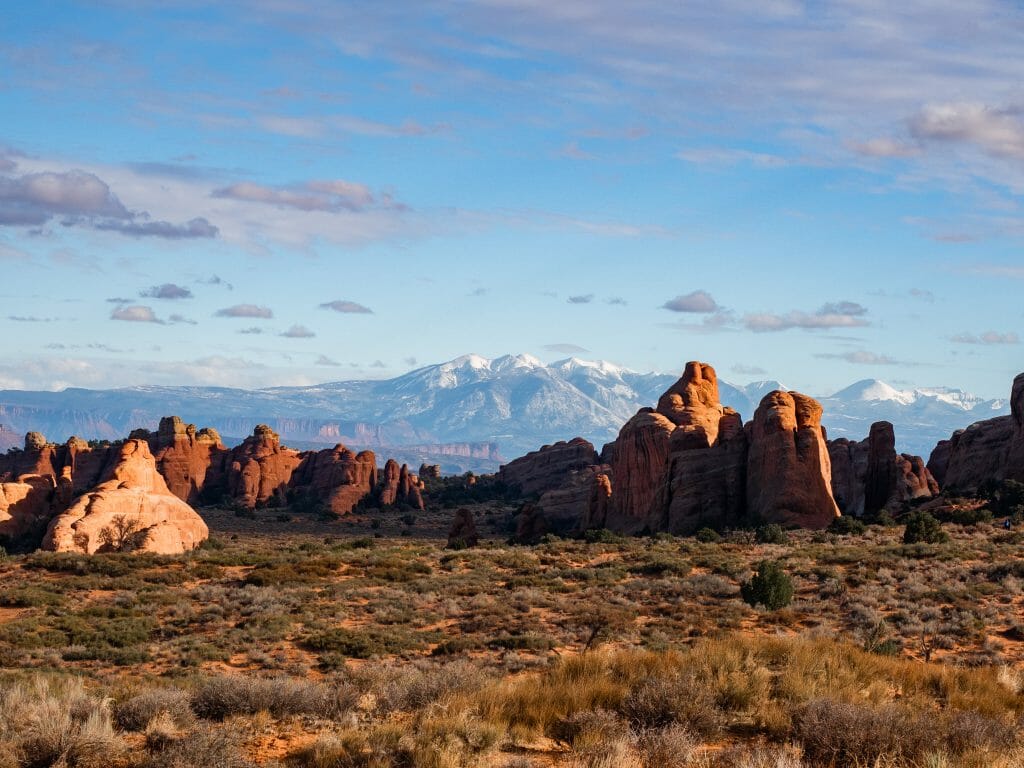
8-15 | Devil’s Garden Trail
16km / 10mi loop | 471m / 1545ft elevation gain | 4hrs

The Devil’s Garden is the longest trail within Arches National Park, taking in no less than 7 arches along a 16km loop. Allow 3.5-4.5hrs (including photo stops and snack breaks) to complete the Devil’s Garden Trail, plus all side trips and viewpoints off the loop. The trail is well signed and easy to follow (with the exception of a few spots on the primitive trail, but thankfully there are always other people around, so it would be near-impossible to get lost).
Many visitors hike out as far as Double O and then turn back, but I highly recommend completing the entire trail— not only is there another spectacular arch on the other side of the loop, but the view of the La Sal Mountains behind spectacular orange rock formations is truly out of this world.
To that end, I’d also recommend walking clockwise, so that you finish on the primitive trail, which will give you better views looking towards the trailhead. This section requires more route finding and a tiny bit of scrambling across the rocks, but it’s manageable for most anyone with a reasonable fitness level.
Tunnel Arch
The first arch that you’ll reach along the Devil’s Garden trail is just a few steps off the loop, looking back up at a deep tunnel carved through the rock.
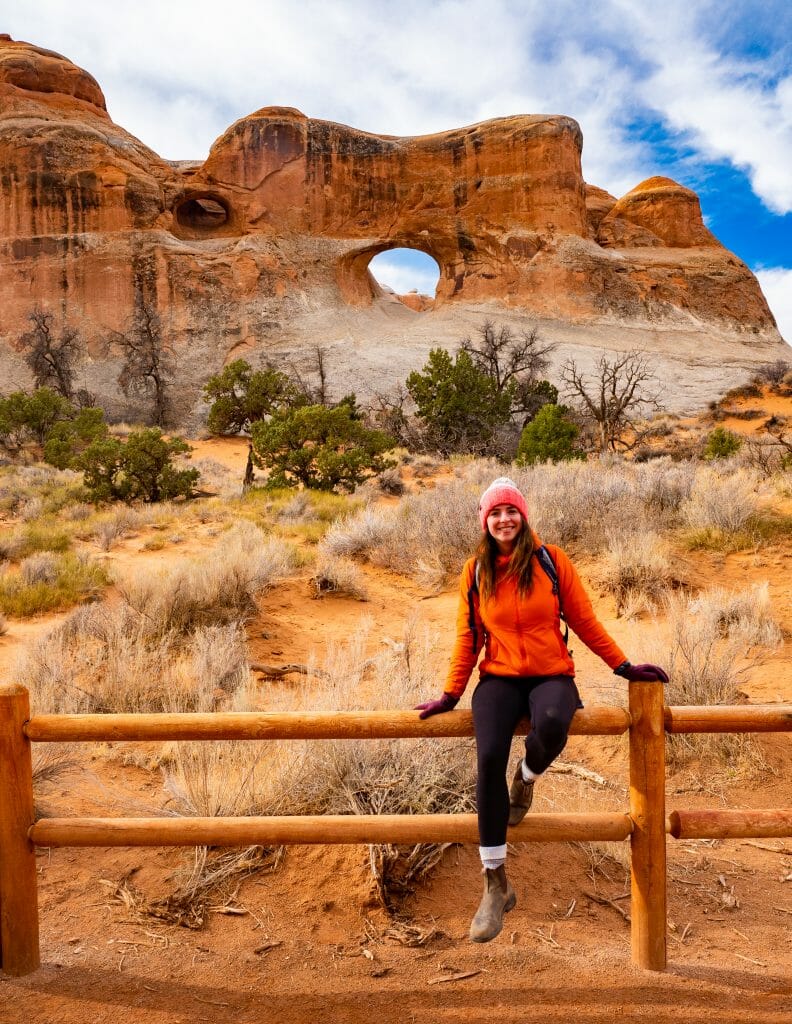
Pine Tree Arch
Shortly after Tunnel Arch, the trail leads out to Pine Tree Arch, a large and spectacular round arch tucked away behind pine trees. This is a great place to take photos inside an arch, as there’s no climbing involved to get into the rocks.
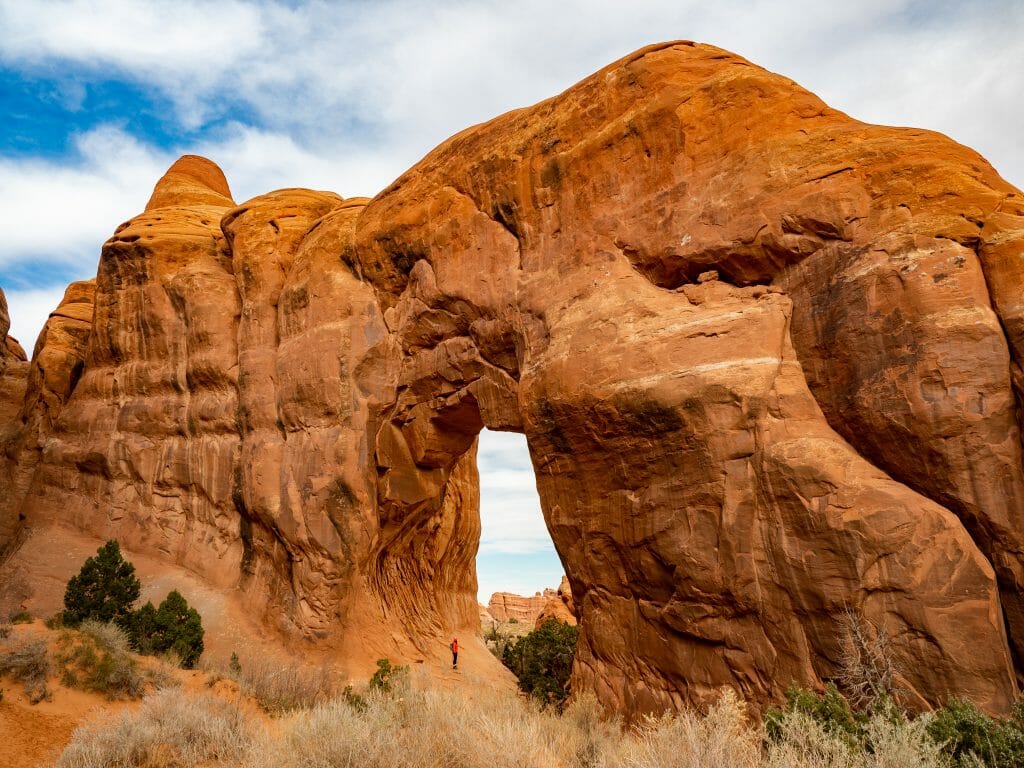
Landscape Arch
One of the most visually impressive of the arches on this trail, Landscape Arch is a soaring, slender arch hanging over a sloped hill of pines and scraggly bushes.
In geological terms, it’s probably not long for this world, one rock-fall away from the slender ribbon crumbling entirely into the brush below.
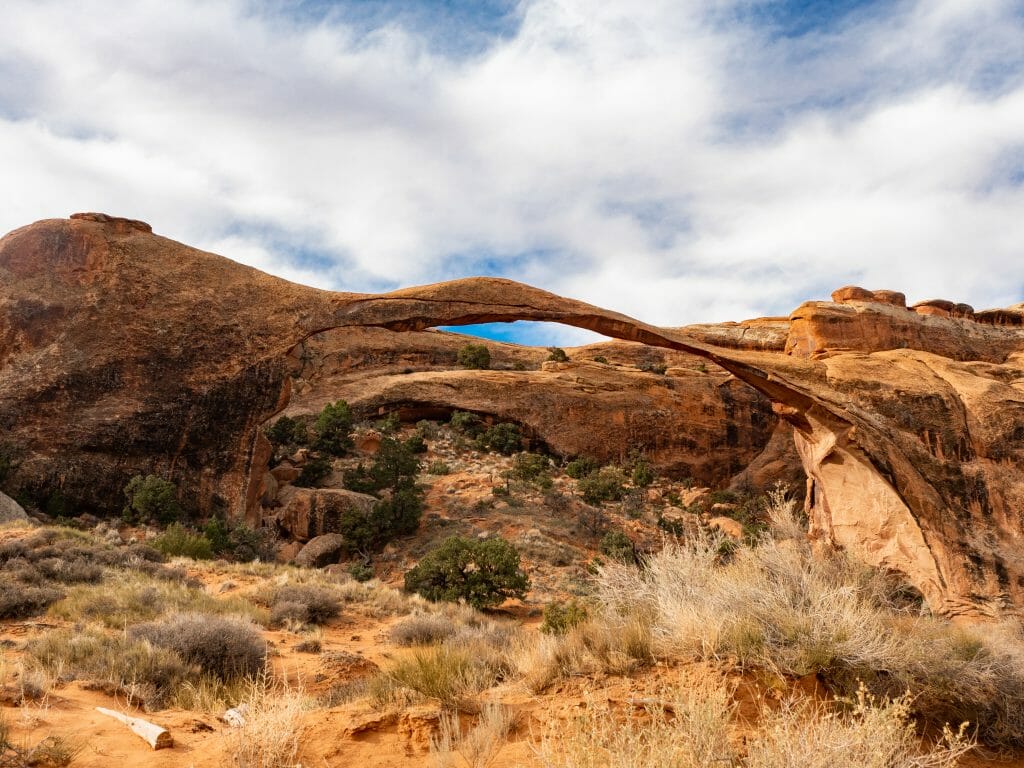
Partition Arch
You get a view onto the front side of Partition Arch as you’re climbing over the rocks heading upwards from Landscape Arch, but for a view around the back side, walk a few hundred metres off the main trail.
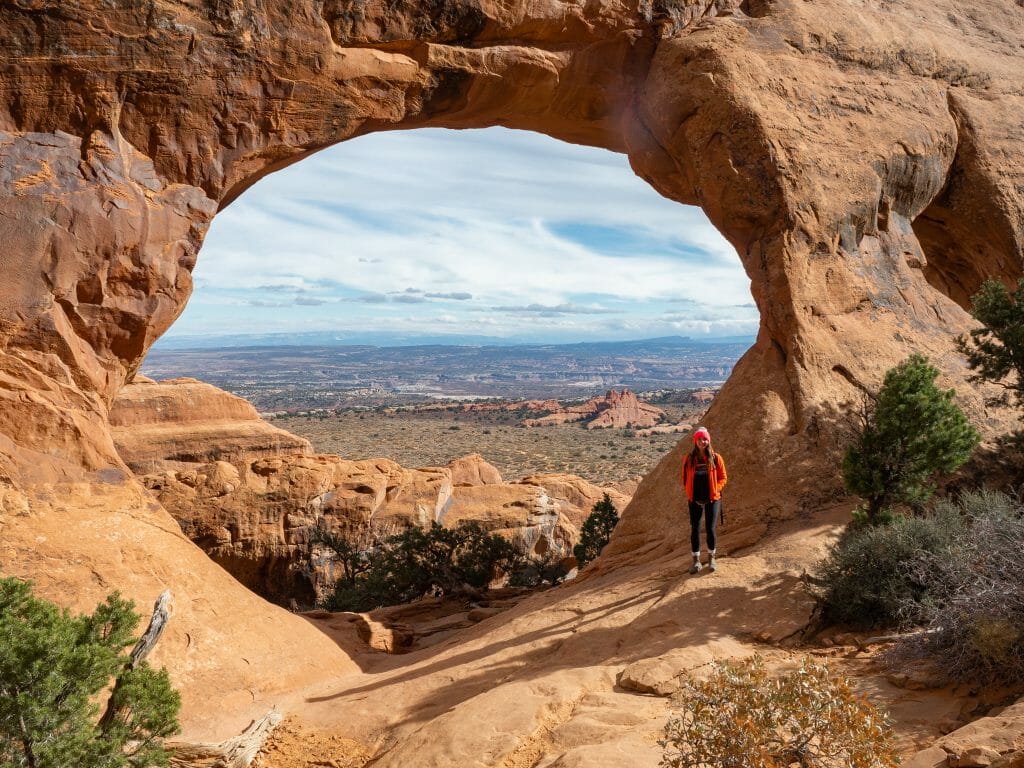
Navajo Arch
From the same trail junction as Partition Arch, turn right and walk several hundred metres out to Navajo Arch, another deep-set arch through the base of a giant orange rock wall.
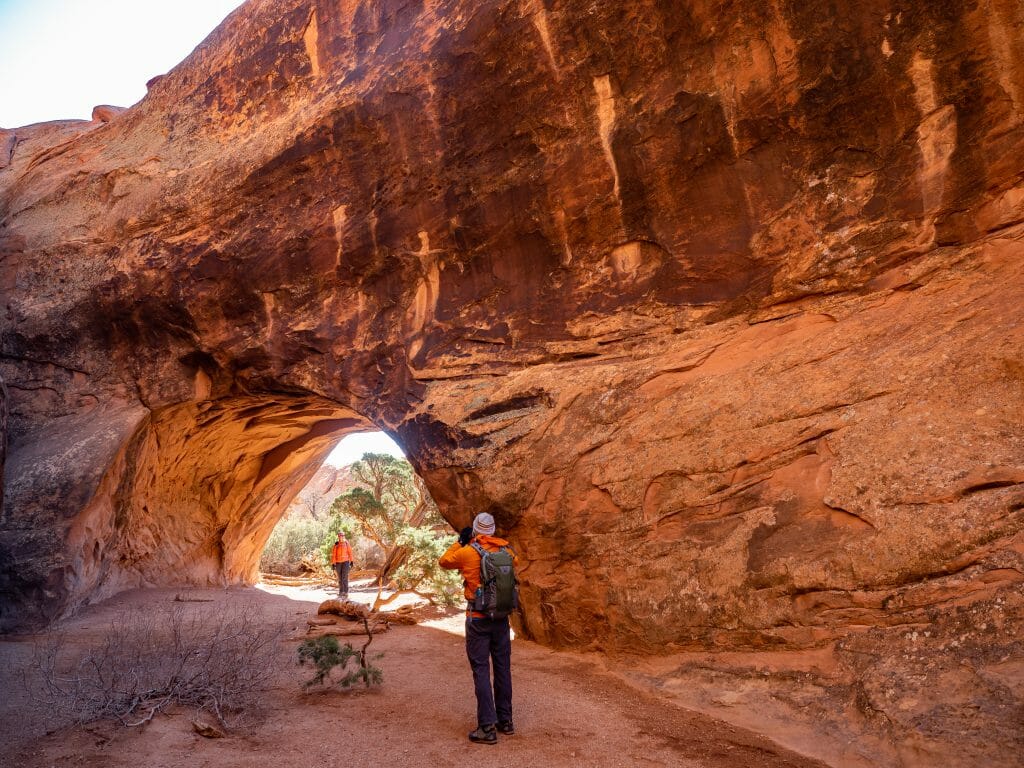
Double O Arch
Continuing along the loop, the next arch on the list is Double O, providing a distinctly different configuration of twin arches than the heart chambers of Double Arch or the bespectacled Windows.
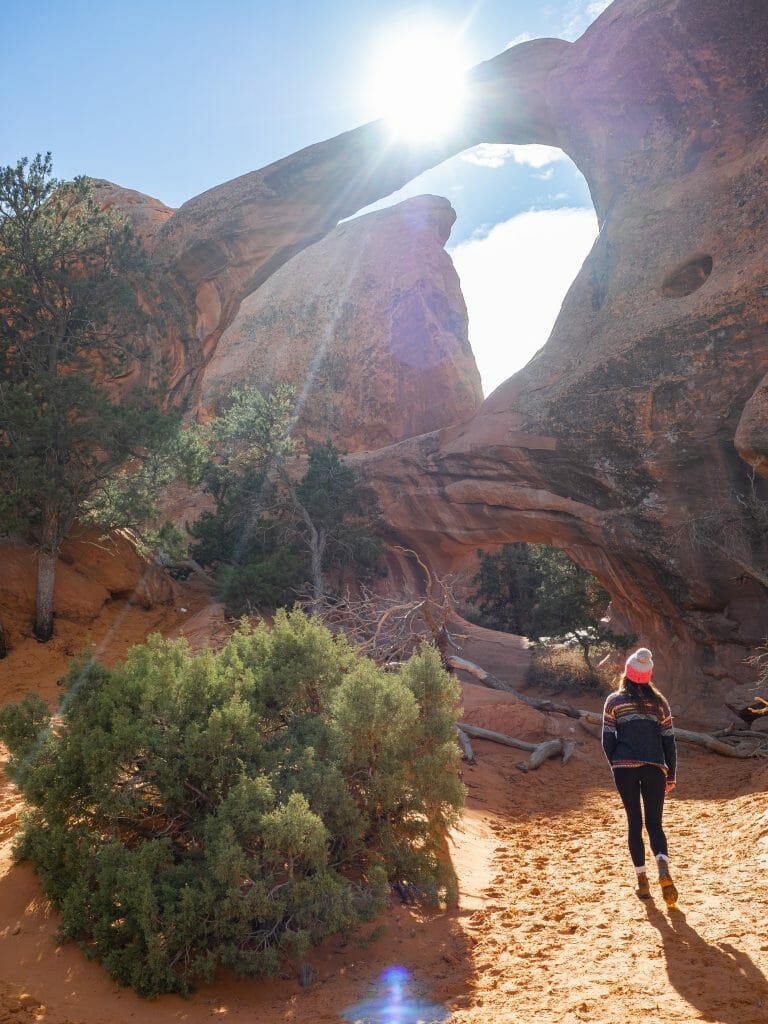
Dark Angel
Leaving the loop behind, walk for about 15min to reach a 45m (150ft) towering column of red rock rising entirely alone from an otherwise flat landscape. This section of the trail sees fairly minimal foot traffic, making it a good place to spot wildlife or just enjoy a quiet snack break before continuing back to the main trail.
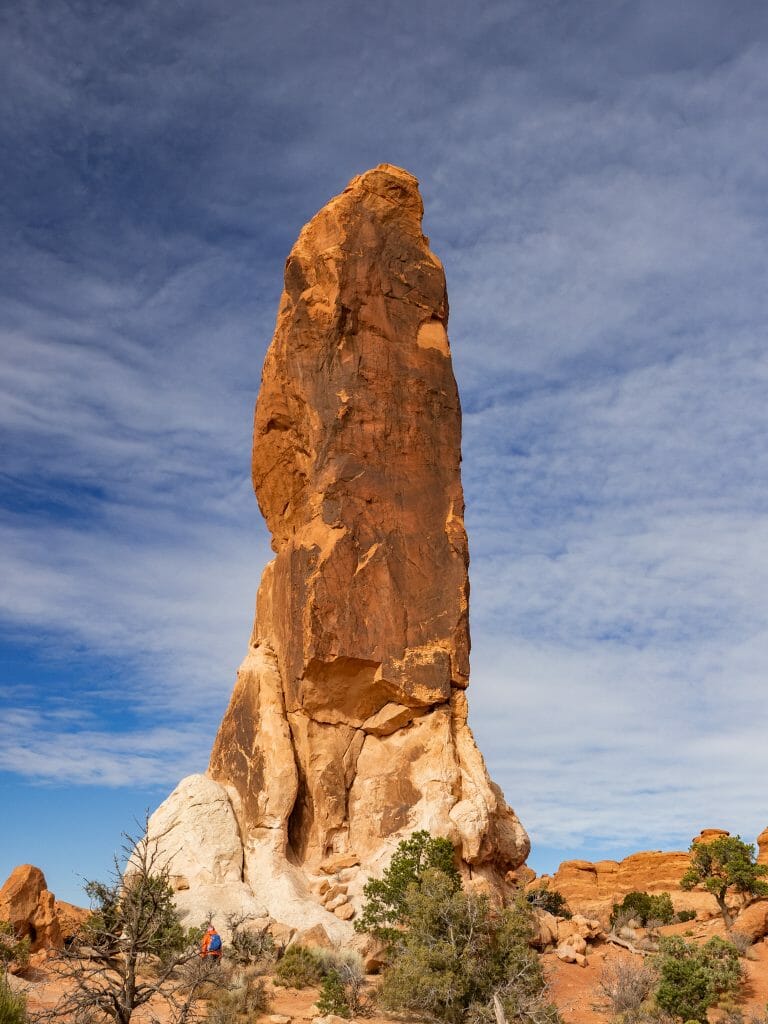
Private Arch
The final arch of the Devil’s Garden Trail is another short jaunt off the main loop, slightly challenging to see until you’re practically on top of it.
From here, there’s a long stretch of arch-less hiking to get back to the car, but assorted sandstone formations offer plenty of visual interest, as do the striking views of the La Sal Mountains that you’ll enjoy as you near the trailhead.
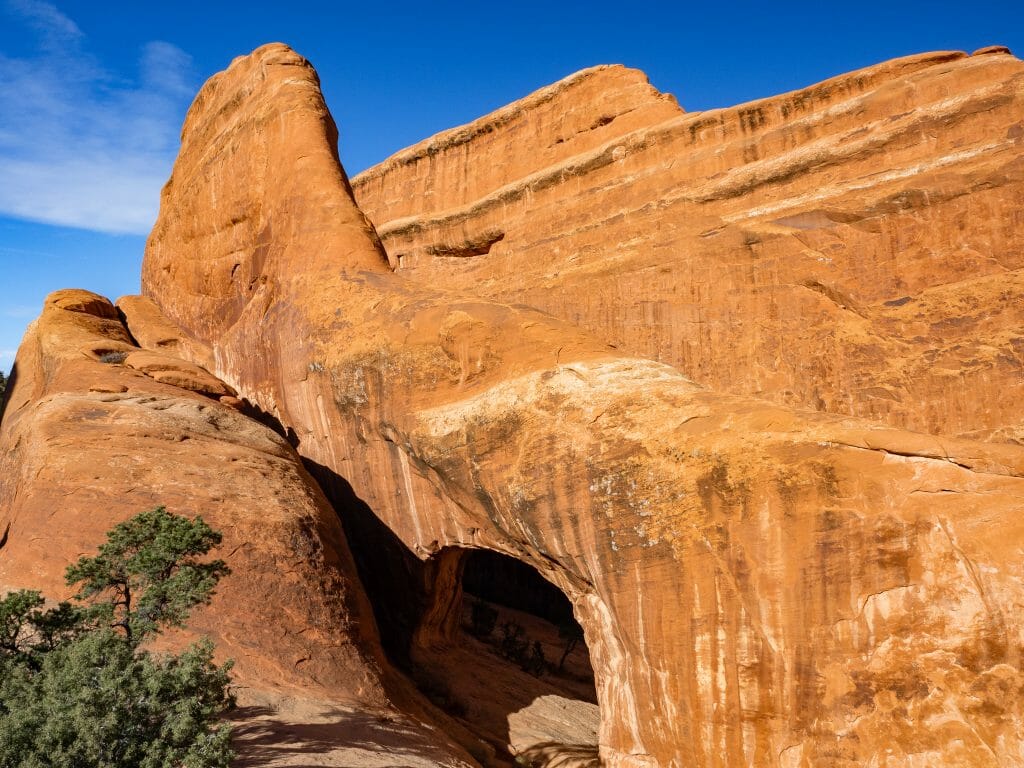
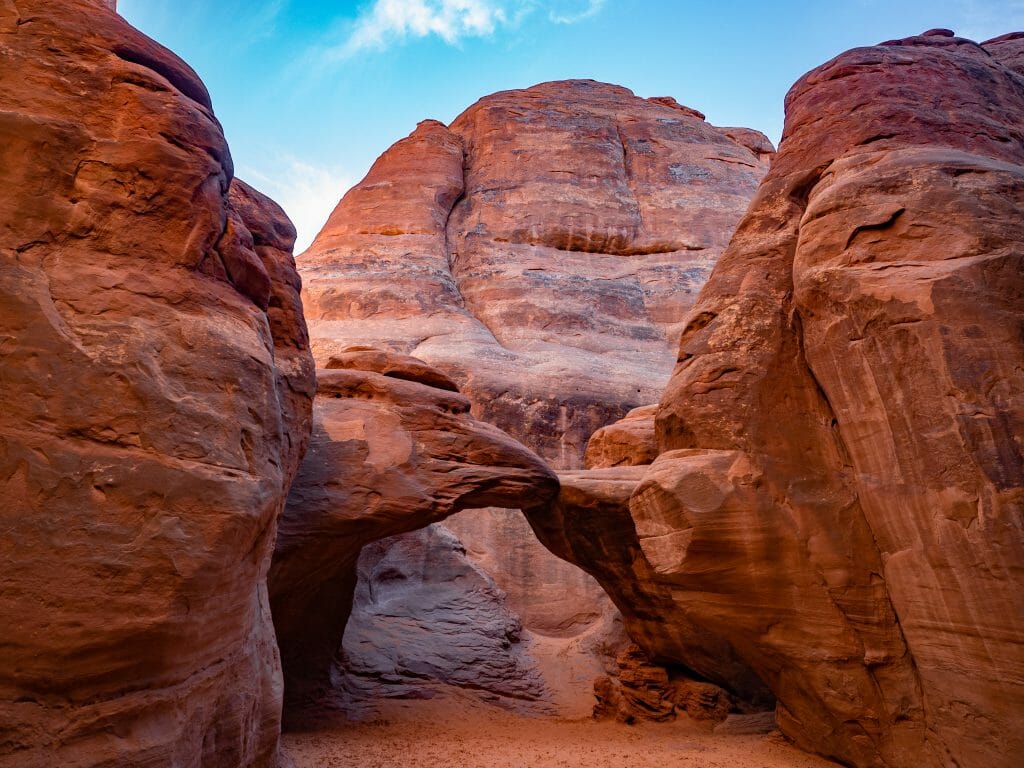
16 | Sand Dune Arch
500m / 0.3mi return | 10min
Following a short trail through thick sand and a narrow rock opening, Sand Dune Arch is another excellent stop to squeeze in en route to Delicate Arch, uniquely joined like a bridge between larger sandstone faces.
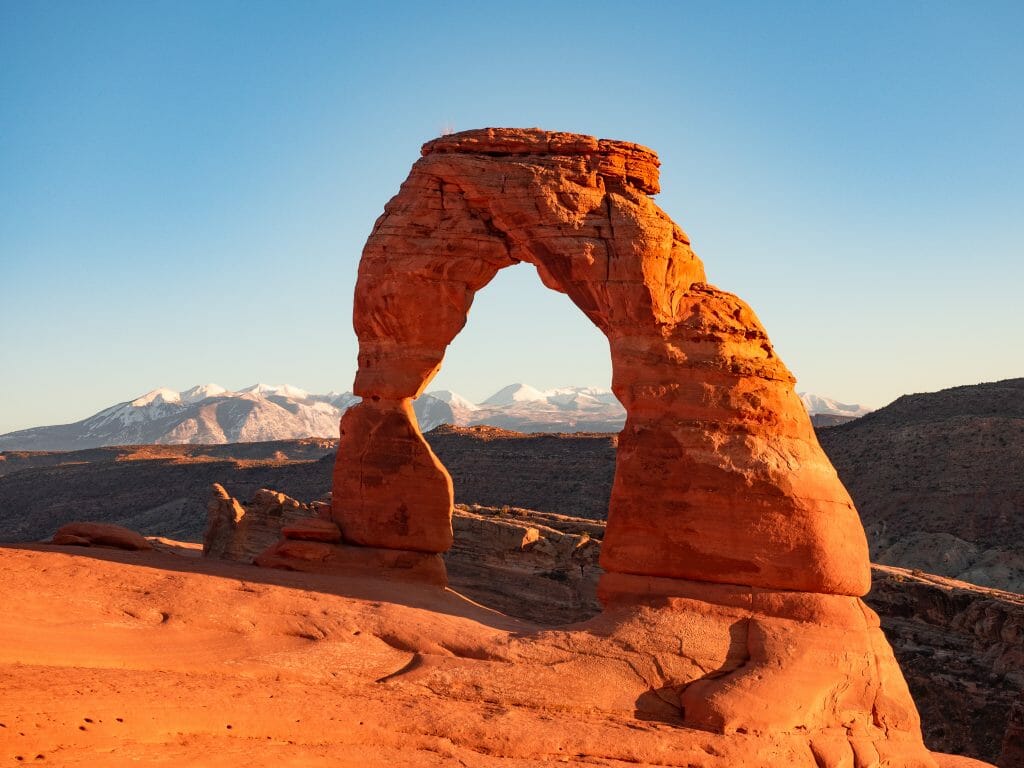
17 | Delicate Arch
4.8km / 3mi return | 150m / 490ft elevation gain | 1-1.5hrs return
Arguably the most spectacular arch in the entire park, watching sunset at Delicate Arch is the perfect way to wrap up a full day exploring Arches National Park.
The hike is recorded as difficult on the map, and it is more challenging than any other trail in Arches, but it’s really not difficult according to any other hiking standards. There is some rocky terrain, so good footwear is required, but the uphill climb only takes about 30min and should be achievable for most anyone!
Once at the top, find yourself a good spot in the rock amphitheatre and watch as the sun ignites the ribbon of Delicate Arch in an impossible orange glow and casts a soft pink across the distant snowy peaks of the La Sal mountains. There’s a reason Delicate Arch features on the Utah licence plate— it is pure magical, a geological wonder that defies reason and will leave you with the perfect parting image of Arches National Park.
Explore more US National Parks & Public Land
THE ULTIMATE 1-DAY JOSHUA TREE NATIONAL PARK ITINERARY: 9 BEST HIKES & SCRAMBLES (POST-COVID)
THE ULTIMATE 1-DAY RED ROCK CANYON (LAS VEGAS) ITINERARY: 9 BEST HIKES & VIEWPOINTS
THE ULTIMATE 1-DAY YOSEMITE NATIONAL PARK ITINERARY: 11 BEST VIEWPOINTS & HIKES (POST-COVID)

The Comments
northierthanthou
Spectacular images here.
brooke brisbine
northierthanthouThanks so much for reading!